When people ask me if they can keep coyotes as pets, I’m tempted to say, ”You betcha!” I mean, people keep all sorts of exotic and dangerous animals. Those animals are far more likely to turn on them one day and rip them to shreds.
Whenever I get asked if a pet coyote is a good idea, I know a new kid’s movie or television show just came out, and a cuddly coyote is the main character.
Let’s face it, most people never see a coyote, fewer still catch a glimpse of one on the road or in a field, and conceivably 1% get within petting range.
Coyotes are opportunistic, surplus killers, not pets. Keeping coyotes as pets is illegal or require a permit in the United States and Canada. Pet coyotes require highly specialized training and housing facilities. As apex predators, they are intolerant of domesticated dogs, cats, and livestock.
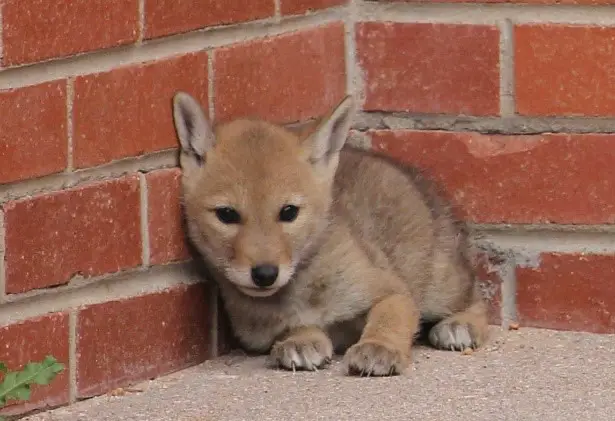
Why keeping coyotes as pets is a dumb idea.
No matter what anyone tells you, a coyote cannot be raised, trained, and live like a pet dog.
Ripley, my female English Mastiff, is the result of nearly 150 centuries of selective human breeding. Her ancestors evolved (if you can call all that human meddling evolution) with the ones who satisfied human needs and could handle the diet they were fed, surviving and breeding future generations.
On the other hand, Wiley coyote is an opportunistic, surplus killer governed only by instinct. Wiley is a very adaptable animal, but only so far as in his ability to survive in various geographic areas.
Even if you purchase a coyote puppy (it is legal in some states) that has been bottle-fed, frequently, and regularly handled by humans, you are only buying a tame coyote pup. True domestication, which would allow Wiley to fit in, and bond with you and your other animals and pets, will take him about 830 generations (given typical ”captive” coyote lifespans).
Until then, Wiley and all his future offspring will remain undomesticated. They will chase anything that catches their eye, kill any puppies you bring into the house, bite your children, attack strangers, and seek desperately to be rid of you.
When they escape, you’ll hear about the damage they do to local farms, sometimes in the form of a collar, some puzzled farmer with a shotgun brings back, along with a bill for his dead ducks.
When they escape, you’ll hear about the damage they do to local farms, sometimes in the form of a collar, some puzzled farmer with a shotgun brings back, along with a bill for his dead ducks.
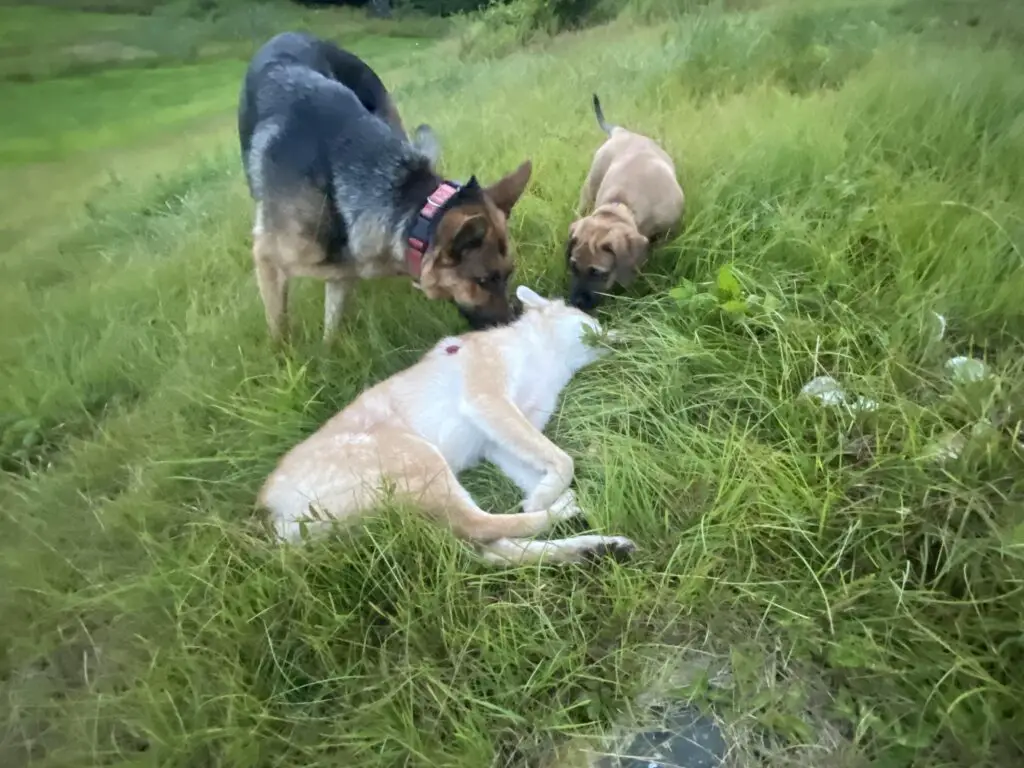
Exercising a pet coyote is an impossible feat.
Lana, my German Shepard pictured above, was raised on a farm with no fences or rules (aside from leaving the livestock alone). Left alone, she will run 7-10 miles a day. She is a coyote in her heart.
A wild coyote will also travel 10 miles a day. So, how will you ensure Wiley, your pet coyote, will get enough exercise to keep him happy and somewhat obedient?
I’m sure the kids promised to walk their pet coyote, but will they keep their word? Will they walk it at least twice a day?
Seriously, you can’t snap a leash on a coyote and hit the sidewalk. Your pet coyote, outdoors, will leave 90% of his tamed self at home. Every flitting bird and grasshopper that goes by will drive him wild with the urge to chase and kill.
And when your pet coyote meets another strange human or dog, he will strain at his leash to attack it. To Wiley, if it isn’t prey, it’s a competitor. A trespassing competitor.
Got a hold of that leash? This will be a blast! Just for giggles, let’s take Wiley to the dark park.
Pet coyotes can never be taken for walks or allowed to enter dog parks. Their territorial and competitive instincts, unaffected by mere taming, could result in conflict and injury to other people or pets.
People keeping coyotes as pets are limited to exercising them in large, well-secured, and fenced-in compounds. As expensive as such facilities are to build and maintain for private citizens, they cannot provide sufficient physical or mental activity to maintain a coyote’s health.
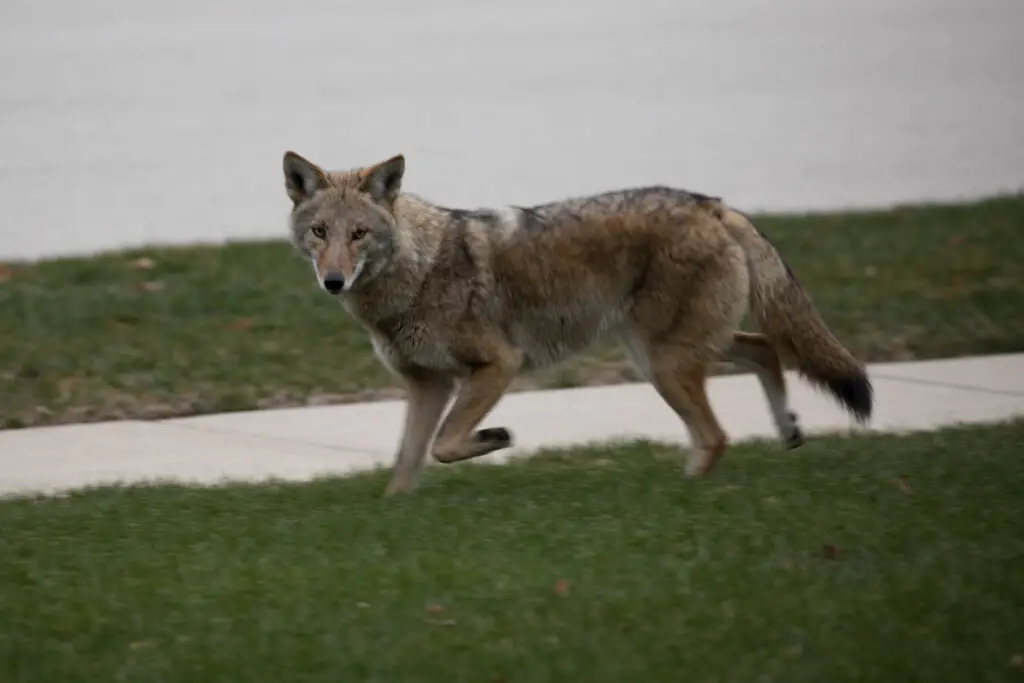
Feeding your pet coyote.
I suggest you begin with my article on what a coyote eats in the wild because it will be after it escapes if you don’t meet your pet coyote’s dietary needs.
In the wild, a coyote will consume almost anything it finds, including human trash. In your home, however, you will have to either match the diet used by researchers studying captive coyotes or try to feed it like a domesticated dog.
Feeding a pet coyote a wild diet.
Researcher John Litvaitis in his report titled “Food and Energy Use by Captive Coyotes, ”reported that it took 8 deer, 105 hares, or 4,800 mice per year to fulfill the minimum energy demands at the metabolizable level of a 28-pound coyote.
Even if you live in a remote, rural location, there’s just no practical way to provide such a diet. In most states, you would not legally be allowed to harvest that many deer. I doubt you could consistently get access to roadkill or donations from other hunters to help feed your pet coyote.
And one can only imagine the amount of time, energy, money, and storage space needed to keep a pet coyote alive for just one year.
If you live in the city, your neighbors might object to having their children playing next door to a yard that looks like this.
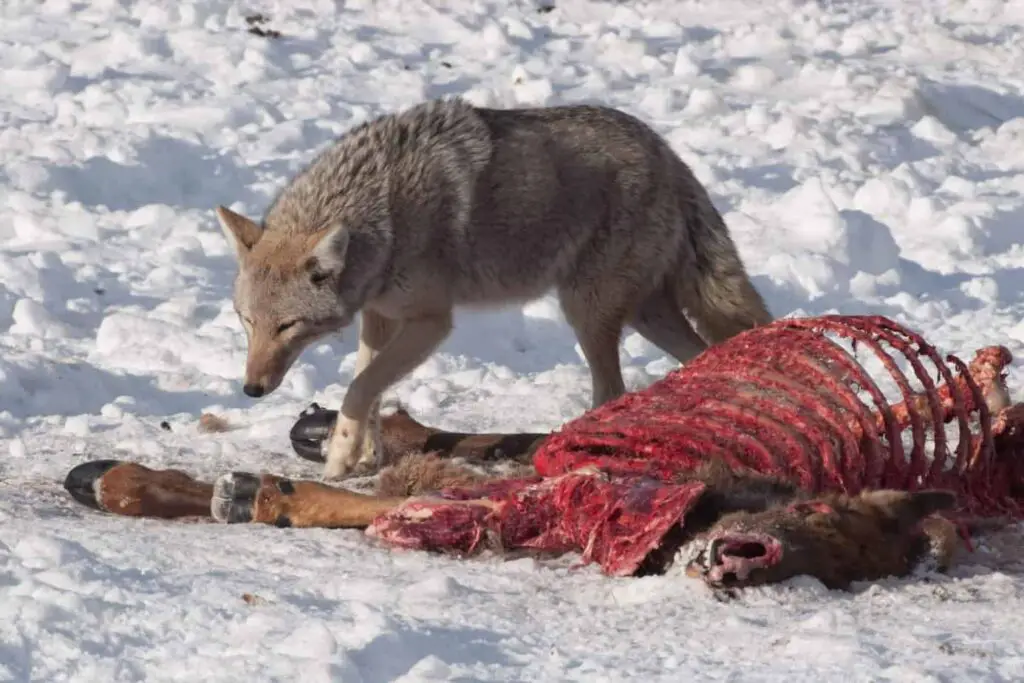
Feeding your coyote pet like a domesticated dog.
Zoos have successfully fed their coyotes commercial dog food for years. However, this diet has to be supplemented with other meats, vegetables, and fruits to meet the complete nutritional requirements of these, basically captive, coyotes.
Again, the cost in time and money involved just to feed them makes having a coyote as a pet unrealistic for most people.
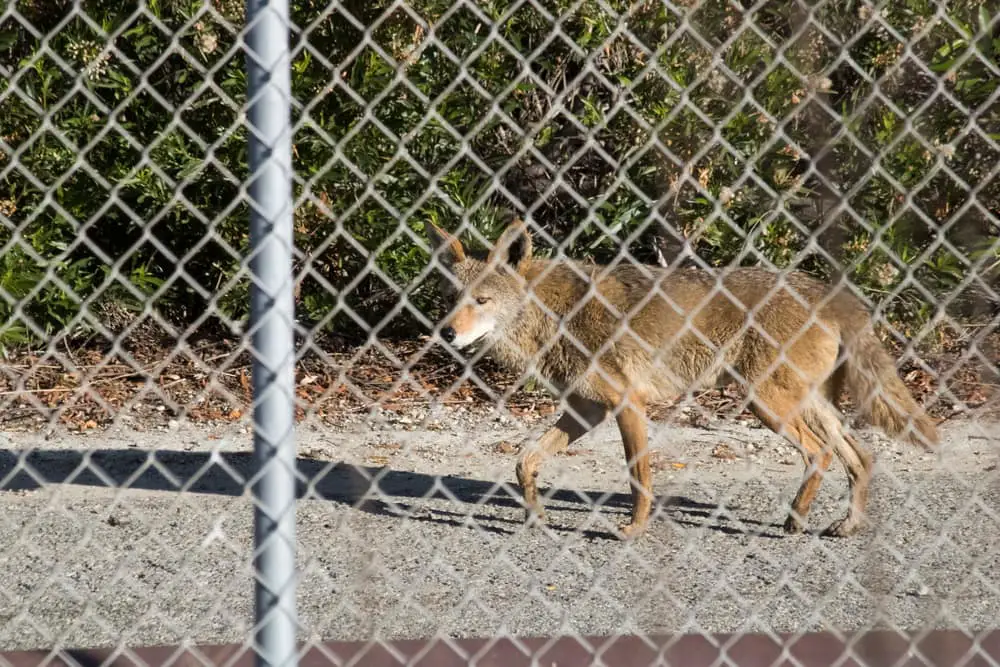
Keeping coyotes as pets requires a prison like fence.
Your constant worry will be keeping your pet coyote from getting loose and wreaking havoc on the neighborhood. No matter how secure you build your coyote’s yard, you’ll spend your day checking and rechecking that it hasn’t escaped.
Coyotes are intelligent, resourceful, and determined animals. Your pet coyote will never stop looking for a way to get over, under, or through any barrier to its freedom. Your coyote will also spend most of its day like a murderer on death row looking for a way out.
The best way to keep your pet coyote safely inside his yard is to copy farmers’ methods to keep them out of theirs.
Building a coyote proof fence.
Any fence designed to keep a coyote out (our keep your pet coyote in) must be tall enough to keep the coyote from jumping over it and be bite-resistant.
Regardless of height, the chicken wire fence and even 1/4” metal hardware cloth will not work. Coyotes will use their teeth to rip openings wide enough to get through these fencing materials.
When selecting the right fence height, realize that while coyotes can only jump about three feet into the air, they will climb over most any sized fence by using their back feet to scale it. A wooden fence with no horizontal features will at least keep your pet coyote from finding a foothold.
Most farmers use a 6’ fence because it’s economical and works to keep drive-by coyotes out. You, however, have a lot more to worry about. If your pet coyote escapes and bites a human, you’ll wish you’d spent thousands more on fencing.
An eight-foot tall fence will have to be your starting point. And here’s what some parks use to keep coyotes from climbing over a fence.

Other fencing needs to keep a coyote inside your yard.
Farmers know a coyote can dig a hole under a fence large enough to crawl through in a few minutes. They often bury 1/4” hardware cloth perpendicularly under their fence to prevent this. You should bury this cloth under several inches of soil and extend it two feet inside your pen from the fence line.
No matter how secure you build the fence to keep your pet coyote inside, it must be checked at least once or twice a day. Examine every inch for places your coyote may have started tearing or digging, and fix them right away.
One last piece of advice, keep all objects at least feet away from your fence. This should keep your coyote from using an object to gain additional height and jumping over it.
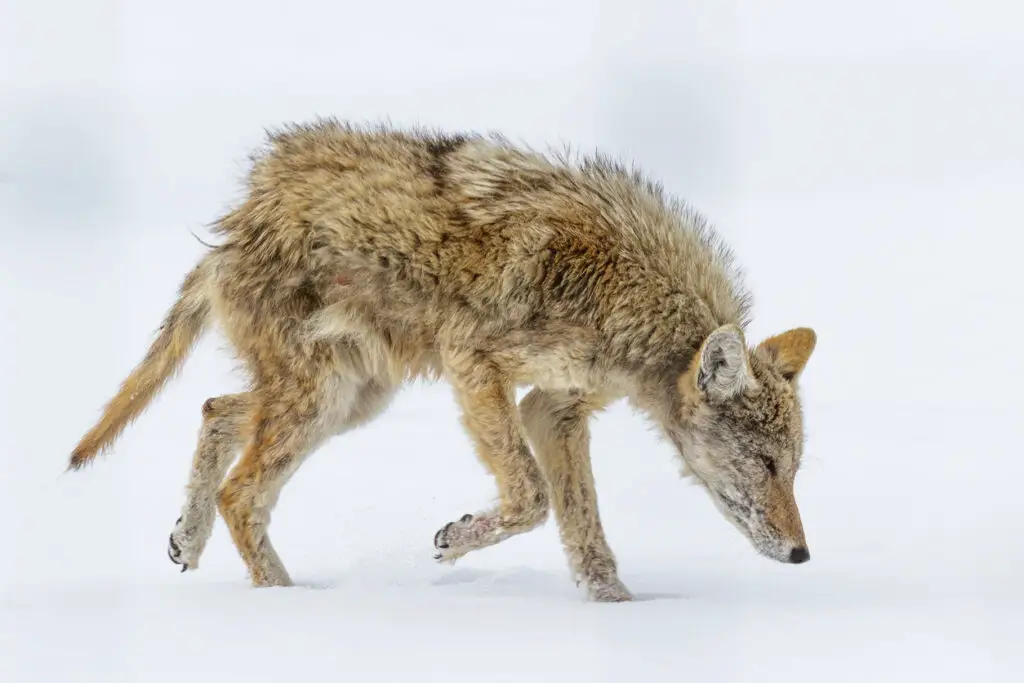
Coyotes as pets: Finding a veterinarian.
Should your pet coyote become ill, where will you take it for medical treatment? Honestly, most vets can’t even tell a coyote from a dog. There is always at least one story in the news about a person bringing a stray “puppy” or injured “dog” to the vet, where, after sometimes an embarrassingly long time, the vet is shocked to discover they have been treating a coyote by mistake.
Your local vet won’t be willing or licensed to treat a pet coyote. In the end, you may need to use the services of a wildlife rehabilitator. Such medical services could be costly, and you are unlikely to find an insurance policy covering medical treatment for a coyote.
Diseases found in coyote pets.
Coyotes can carry and transmit various diseases such as heartworm, mange, canine distemper and hepatitis, rabies, and tularemia in the wild. They are also often covered in fleas and ticks.
The potential for introducing any of these diseases or parasites into your homes is reason enough never to capture or pick up a coyote and bring it inside your house.
If you purchase your coyote pet as a puppy from a licensed breeder, mange, rabies, and parasites won’t be your problem. Getting shots for canine distemper and canine hepatitis, rabies, and other disorders like lime disease, however, will be difficult to impossible.
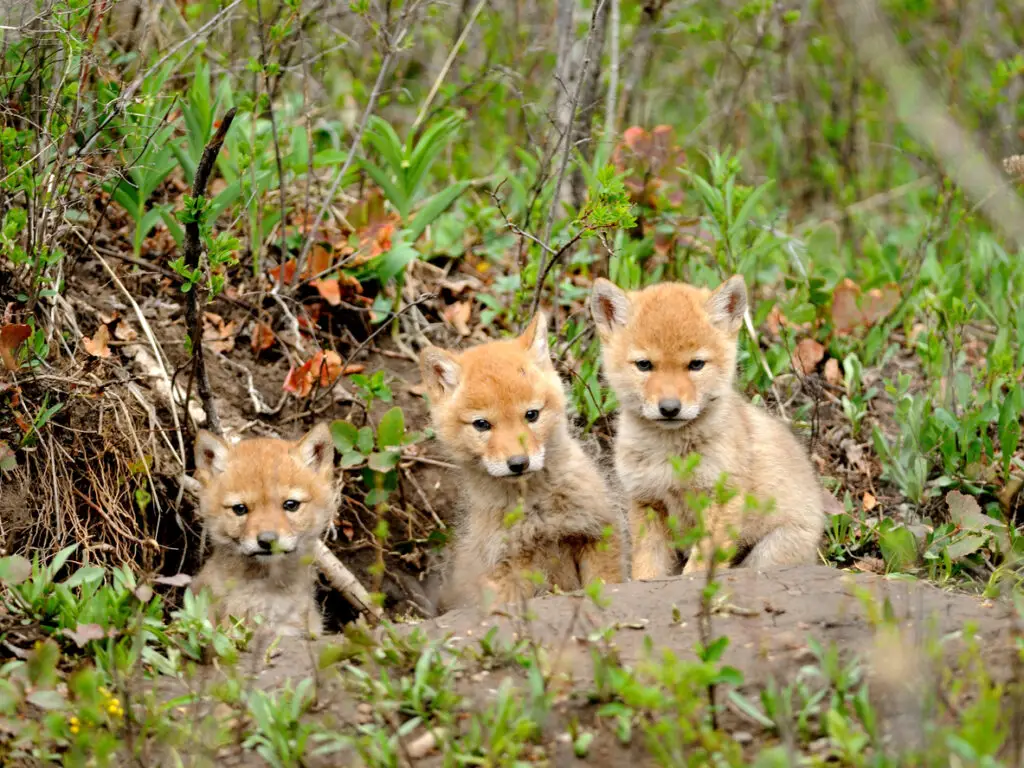
Breeding coyotes as pets?
If you are still reading, you might be caught up with the idea you can somehow make money breeding and selling coyote puppies. There certainly are people who do it.
Here’s what those who legally engage in it in Tennesse have to do in order to meet all the legal requirements.
Applicant experience requirements
(A) The applicant must be at least twenty-one (21) years of age;
(B) The applicant must have at least two (2) years of experience in the handling or care of the Class I species for which the applicant is applying, or, in the alternative, must take a written examination, developed and administered by the agency, evidencing basic knowledge of the habits and requirements, in regard to proper diet, health care, exercise needs and housing of the species to be covered by the permit. Experience gained while in violation of this part shall not be considered qualifying experience.
Facilities and recapture requirements.
(C) The facilities for holding Class I wildlife must be located on the premises on which the permit holder resides or shall have a full-time resident caretaker to supervise the care and security of the facilities. Facilities for Class I animals may not be on premises of less than one (1) acre for a personal possession permit and three (3) acres for a commercial propagator facility permit, and may not be located in a multi-unit dwelling or trailer park; and
(D) The applicant must have a plan for the quick and safe recapture of the wildlife, or if recapture is impossible, for the destruction of any animal held under the permit. The applicant must have the legal authority to possess weapons or other equipment necessary to carry out the plan and, in fact, possess such weapons or other equipment.
(3) The permittee shall control and maintain Class I wildlife at all times in such a manner as to prevent direct exposure or contact between the animal or animals and the public; provided, that a trained elephant may be brought into contact with the public under the close supervision of a qualified trainer or handler.
(d) No person shall hold live wildlife in captivity without first obtaining the appropriate permit as provided in this part. The annual permits and fees for holding live wildlife are as follows:
(1)(A) Personal Possession. Class I: $150/animal or $1,000/facility; and
(B) Class II: $10.00/animal or $100/facility.
There’s million reasons not to keep coyotes as pets.
At the end of the day, keeping a coyote as a pet is cruel, if not criminal. Coyotes are wild dogs that have not spent centuries accompanying man and adapting to our lifestyle and diet.
Coyote puppies may look cute, but they are born to be apex predators and surplus killers. There is no life for them trapped behind high walls and eating canned food.

